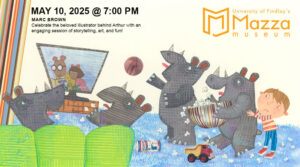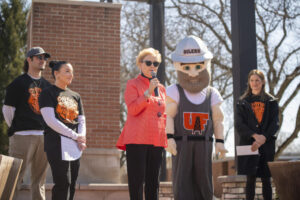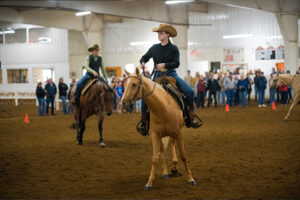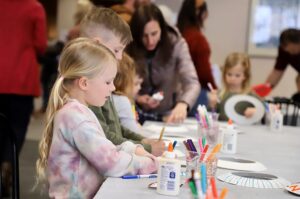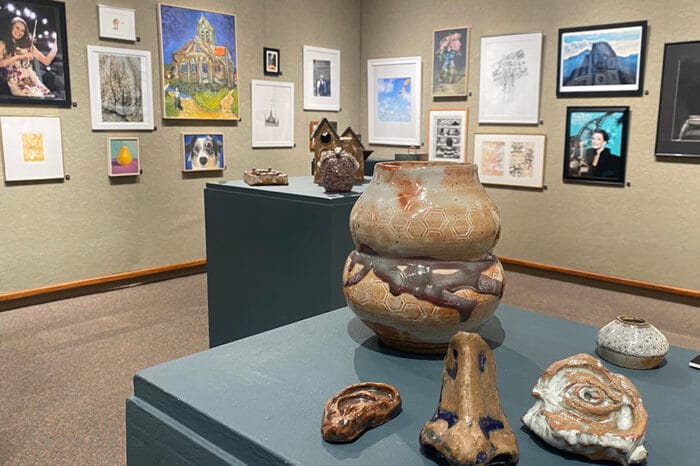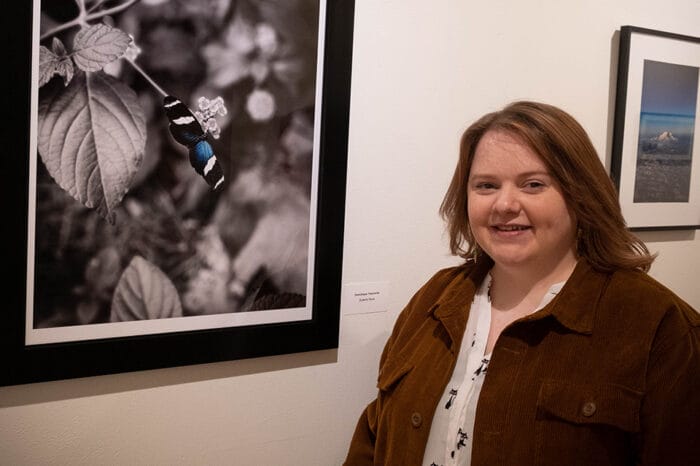‘She was always Marianna’

 (Written by Sara Arthurs, staff writer for The Courier. Story originally published on May 2, 2018).
(Written by Sara Arthurs, staff writer for The Courier. Story originally published on May 2, 2018).
A keen intellect. A generous heart. Also, a sharp tongue.
These are among the attributes friends recalled in describing Findlay poet and photographer Marianna Hofer.
A year after her death, Friday will be Hofer’s final ArtWalk. Proceeds from the sale of her work will go into The Marianna Hofer Arts Endowment Fund.
It’s the first time Hofer’s second book, “The Weight of the Minolta in Her Hand,” will be available to the public, said Elaine Bruggeman, a close friend. Hofer was working on the book when she became ill. Her friends finished it after her May 3, 2017, death at age 63.
“She was a spectacular poet,” Bruggeman said.
Hofer’s poems were published in literary journals across the country. She also taught writing at the University of Findlay, and she wrote in her journal every day, her obituary states.
She “handled her photography like a poet,” said artist Phil Sugden, who has a studio near Hofer’s former space in the Jones Building and had known her since the 1990s. She might photograph little things, he said: a broken piece of something larger, or paper peeling off a wall, or objects you wouldn’t recognize out of context.
Sugden recalled offering Hofer a ride when she’d walk through town. But, he said, she walked by choice – for the exercise, but also because she would see things along the way, in the alleyways.
“She always had her camera in her hand,” Sugden said.
Hofer took photographs on film, and in black and white.
Sugden said she’d take the film to Bowling Green for processing. Then, back at the Jones Building, she’d hand-color the prints.
You could always tell when she was at the Jones Building, because you could hear “the clicking of an old typewriter.” Sugden said Hofer wrote her poems on a manual typewriter, using White-Out if needed. He said Hofer struck him as “a little bit old-school… and it made her work honest.”
Bruggeman recalled that Hofer “dug her heels in” in her insistence that she would not have a cellphone. Then she showed up early one morning at Bruggeman’s business, Main Street Deli, her skirt covered in mud. (Hofer always wore skirts, Bruggeman said). Hofer said she’d been out photographing “an old dilapidated farmhouse” and fell through the porch.
“Get a God-blessed cellphone,” Bruggeman told her friend. (Hofer finally complied, but remained “reluctant to text.”)
Bruggeman said Hofer was very “close to the chest” in creating her own poetry: “All of her poetry was very, very much her heart.”
“She was always Marianna,” she said. “She never pretended to be who she wasn’t.”
Sugden recalled a regular “subculture party” years ago in Findlay, with invitation by word of mouth. Different subcultures would come together, including the LGBT community and artists. Themes included “The Hair Ball,” “The Red Party” and “The Come As You Aren’t Party.”
“Marianna was a big part of that,” Sugden said of the parties, which Bruggeman described as “outlandish as you could possibly be.”
She, too, met Hofer in the 1990s, through mutual friends. They quickly became close, as they had a similar outlook on life with “little hints of cynicism and a lot of sarcasm. But she was truly genuine. She was one of the good people, she really was.”
Bruggeman has a degree in English and the two shared a love of literature. Bruggeman said Hofer particularly loved “Moby Dick.”
“All those transcendentalists – she loved them all,” she said.
Bruggeman is more interested in modern literature, but the women would recommend books to each other.
“We did share an equal dislike for William Faulkner” which they held onto, “all claws in,” Bruggeman said.
And they shared a love of local restaurants.
“Talking and eating – that’s what we did,” she said.
Hofer shared stories about her students at the University of Findlay, where she taught writing for 32 years.
“She was something else,” said English department chairwoman Christine Denecker.
Hofer would always have a story to tell at any faculty meeting. She’d tell stories at the photocopier, too, but was also prone to swearing at it, Denecker said.
Denecker said Hofer was unique and “made her mark on lots of generations of Oilers.”
“She had such a heart for her students,” Denecker said, adding that they were “at the center of everything she did.”
Hofer, as a poet, taught creative writing, but she spent the bulk of her time in “College Writing 1” courses. In this course, students get an introduction to academic writing as they transition into college. It can be difficult for students without a writing background, Denecker said, but Hofer “was just always very persistent.”
“And she always did it with a sense of humor and lots of irony and sarcasm,” she said.
Bruggeman said, “She saved thousands of freshmen who would have flunked out… with patience, a sharp tongue and a kind heart.”
And she’d teach them to be worldly and well-rounded, teaching them “more than what was in the book,” Bruggeman said.
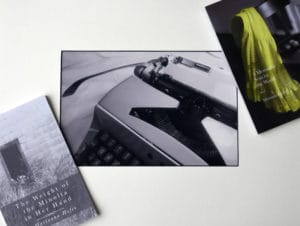
Poetry books by Findlay writer, photographer and University of Findlay professor Marianna Hofer are shown with an original photograph of the typewriter she used to type her poetry. (Photo by Courier photographer Randy Roberts).
“She was so, so smart,” Bruggeman said.
After Hofer’s death, students and alumni told faculty how she had gone out of her way to make sure they had what the needed. Students were “extremely devoted to her” and knew she was “invested in them,” Denecker said.
She card about them – but she was tough.
“She wasn’t going to slide you through,” Denecker said.
Hofer helped with the student literary magazine, “From the Writer’s Kitchen,” and Denecker said helping them get their poetry and prose out there was “dear to her heart.”
She’d do little things like bring snacks to student events, and was “very generous,” Denecker said.
“But on the outside she would be kind of crusty about. …She didn’t want you to know she had this big heart on the inside,” Denecker said. “But it was huge.”
Bruggeman said immediately after receiving her cancer diagnosis, Hofer advised Bruggeman to talk to her lawyer about setting up an endowment.
The first grants were just awarded in March, with the annual award timed around Hofer’s birthday. Grants go to individual artists or arts organizations.
One of the first grants will go to the Findlay Art League, which will allow the agency to “get serious” about ceramics, said board member Nancy Frankenfield. She said the funds will allow the art league to buy a special sink to dispose of clay, which can plug up the drain.
The money is being invested, and the endowment will be there to help artists “in perpetuity.” Decades from now, artists who never knew Hofer will benefit.
Bruggeman said Hofer wanted to help “struggling artists” – those who might be working a day job, and making art at night. And she wanted the money to stay local, because “she really did love this town a lot.”
The endowment, through The Findlay-Hancock County Community Foundation, is administered through the Arts Partnership.
The reading room at the University of Findlay has recently been dedicated as the Marianna Hofer Memorial Reading Room.
“Her presence is still here,” Denecker said, adding that Hofer’s artwork is in her colleagues’ offices. “We still have her close in that way.”
And Hofer’s office has been turned into a work space for “From the Writers’ Kitchen.”
At the Jones Building, her studio is now occupied by clothing designer and drag queen Candi Wantsome?, a persona created by artist Ben Hippensteel.
Last October, Hippensteel, with Bruggeman’s permission and directions, began packing up Hofer’s things. That first night, he played some of Hofer’s music, read her poetry, and sat in the studio “with all of her things the way that they were left.”
He found that she, like him, collected objects knowing they would at some point have a purpose in art. He came across a box full of dried cicadas and there – after midnight, in the building Hofer herself had described as “gloriously haunted” – “I screamed at the top of my lungs” and then quickly was laughing.
“I’ve felt her in the space since then,” he said. (The two never met).
A sketch of Hofer remains in the studio, along with her glasses and copy of “Moby Dick.” One of her photographs hangs on the wall.
Hofer’s books and photographs will be fore sale at the Jones Mansion, 313 E. Sandusky St., from 5-9 p.m. Friday. All proceeds will go into The Marianna Hofer Arts Endowment Fund.
On television, holiday greetings and ‘the next boogeyman’
Marianna Hofer told The Courier in 2014 that poetry is “an easier way to talk about what I want to talk about.”
But it can be hard to spark interest in poetry, and some people might have negative associations from the way poetry was taught in school, she said.
“People have this weird fear of poetry,” said Hofer, who described her own poetry as “Midwestern” and “narrative.”
She said poetry is “not a lost art” and is “something that surrounds us” in the form of lyrics to popular music, rap and even advertising jingles.
Hofer spoke to The Courier several times on intellectual topics related to creativity and the arts, but also was interviewed in 2013 for a story about television guilty pleasures. At that time she said she didn’t watch much television but enjoyed the “vicarious treasure hunting” on the show “Storage Wars.”
In 2012 she was interviewed about the student literary magazine, “From the Writers’ Kitchen.” She said having students sign contracts to print their work made them feel, “Wow, somebody’s treating me like a serious writer.” And she said literary magazines spread a love of literature, encouraging students to “just realize that literature is the thing that’s really alive.”
In 2008 she offered advice on how to write that annual family Christmas letter, speaking candidly about awful Christmas letters she had herself received.
She encouraged being specific: “If you’re going to say it was a good you, you want to tell people why.” And if you traveled, offer details. If you saw the world’s largest ball of twine, for example, let your readers know.
In 2012, she was interviewed for a story on how monsters go in and out of fashion – vampires becoming less popular and zombies more so.
A question that arose was, if modern writers are making creatures like vampires friendly and less scary, would people run out of things to be afraid of?
“I think it’s the technology,” Hofer said. “I think that’s the next boogeyman.”
Hofer Arts Endowment Grants Awarded
The Arts Partnership has selected the inaugural grant recipients for the Marianna Hofer Arts Endowment Fund:
- The Findlay Art League, for its new ceramics/pottery classes
- Emily Jay for her project Blue: Ablution
- Jenny Hanf for Adobe’s Create Cloud
“The Arts Partnership is so fortunate to have the opportunity to grant funds to these amazing artists and programs. Each project is very different and I think that Marianna would be proud to see that, through her generosity, these artists and art students are able to grow their crafts,” said interim executive director Donna Ridenour.
